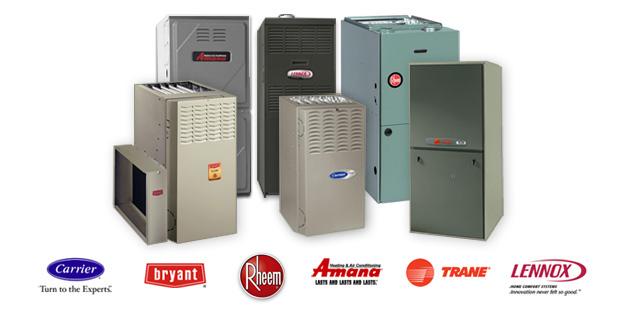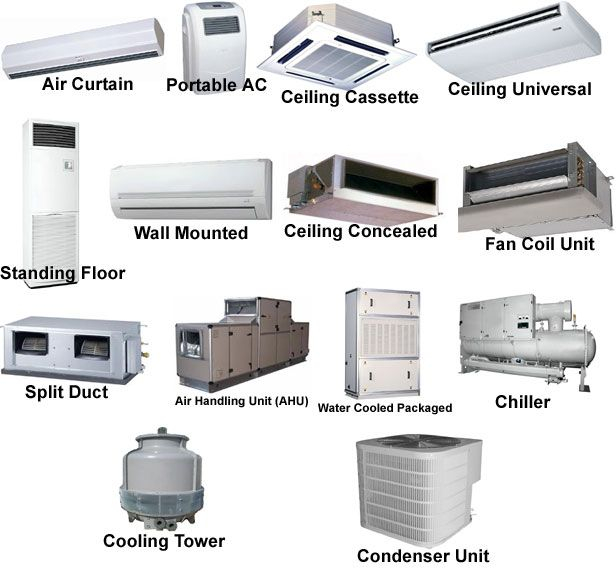Window unit and packaged terminal
Window unit air conditioners are exactly what they sound like. They are installed in an open window. The interior air is cooled as a fan blows it over the evaporator. On the exterior the heat drawn from the interior is dissipated into the environment as a second fan blows outside air over the condenser. A large house may have several of these units,which allows each room to be cooled individually.
Packaged terminal air conditioner (PTAC) systems are also known as wall-split air conditioning systems.These are ductless systems. PTACs, which are frequently used in hotels, have two separate units (terminal packages), the evaporative unit on the interior and the condensing unit on the exterior, with an opening passing through the wall and connecting them. This minimizes the interior system footprint and allows each room to be adjusted independently.
PTAC systems may be adapted to provide heating in cold weather, either directly by using an electric strip, gas, or other heater, or by reversing the refrigerant flow to heat the interior and draw heat from the exterior air, converting the air conditioner into a heat pump. While room air conditioning provides maximum flexibility, when used to cool many rooms at a time it is generally more expensive than central air conditioning.
Split systems
Split-system air conditioners come in two forms: mini-split and central systems. In both types, the inside-environment (evaporative) heat exchanger is separated by some distance from the outside-environment (condensing unit) heat exchanger.
Mini-split (ductless) system
A mini-split system typically supplies air conditioned and heated air to a single or a few rooms of a home. Multi-zone systems are a common application of ductless systems and allow up to 8 rooms to be conditioned from a single outdoor unit. Multi-zone systems typically offer a variety of indoor unit styles including wall-mounted, ceiling-mounted, ceiling recessed, and horizontal ducted. Mini-split systems typically produce 9,000 to 36,000 Btu (9,500–38,000 kJ) per hour of cooling. Multi-zone systems provide extended cooling and heating capacity up to 60,000 Btu’s. Large systems are known as VRF (Variable refrigerant flow) systems.
Advantages of the ductless system include smaller size and flexibility for heating and cooling individual rooms. This means the inside wall space required is significantly reduced. Also, the compressor and heat exchanger can be located farther away from the inside space, rather than only on the other side of the same unit as in a PTAC or window air conditioner. Flexible exterior hoses lead from the outside unit to the interior one(s); these are often enclosed with metal to look like common drainpipes from the roof. In addition, ductless systems offer higher efficiency, reaching above 30 SEER.(The SEER measures air conditioning and heat pump cooling efficiency, which is calculated by the cooling output for a typical cooling season divided by the total electric energy input during the same time frame. A SEER rating is a maximum efficiency rating, similar to the miles per gallon for your car.)
A possible disadvantage is that the cost of installing mini splits can be higher than some systems. However, lower operating costs, rebates, or other financial incentives offered in some areas can help offset the initial expense.
Multi-split system
A multi-split system is a conventional split system, which is divided into two parts (evaporator and condenser) and allows cooling or heating of several rooms with one external unit. In the outdoor unit of this air conditioner there is a more powerful compressor, ports for connecting several traces and automation with locking valves for regulating the volume of refrigerant supplied to the indoor units located in the room.
A large Multi Split System is called a Variable refrigerant flow system and can be used instead of a central air conditioner system, as it allows for higher energy efficiency but it is more expensive to purchase and install.
Its unique feature is the presence of one main external unit that is connected to several indoor units. Such systems might be the right solution for maintaining the microclimate in several offices, shops, and large living spaces.The main external unit can be connected to several different indoor types: floor, ceiling, cassette, etc.
Multi-split system installation considerations
Before selecting the installation location of the air conditioner, several factors need to be considered. First of all, the direction of air flow from the indoor units should not fall on the place of rest or a work area. Secondly, there should not be any obstacles on the way of the airflow that might prevent it from covering the space of the premises as much as possible. The outdoor unit must also be located in an open space, otherwise the heat from the house will not be effectively discharged outside and the productivity of the entire system will drop sharply. It is highly advisable to install the air conditioner units in easily accessible places for further maintenance during operation.
—————–
The selection of indoor units has one restriction: their total power should not exceed the capacity of the outdoor unit. In practice, however, it is very common to see a multi-split system with a total capacity of indoor units greater than the outdoor capacity by at least 20%. However, it is wrong to expect better performance when all indoor units are turned on at the same time, since the total capacity of the whole system is limited by the capacity of the outdoor unit. Simply put, the outdoor unit will distribute all its power to all operating indoor units in such a way that some of the rooms may not have a very comfortable temperature level.
Air-only central air conditioning
Central ducted A/C provides temperature control and ventilation to an area by conditioning air within an air handler and distributing it to one or more zones. The temperature of individual zones can be controlled by varying the airflow to each zone and/or reheating the air.
Portable units
A portable air conditioner can be easily transported inside a home or office. They are currently available with capacities of about 5,000–60,000 BTU/h (1,500–18,000 W) and with or without electric-resistance heaters. Portable air conditioners are either evaporative or refrigerative.
The compressor-based refrigerant systems are air-cooled, meaning they use air to exchange heat, in the same way as a car radiator or typical household air conditioner does. Such a system dehumidifies the air as it cools it. It collects water condensed from the cooled air and produces hot air which must be vented outside the cooled area; doing so transfers heat from the air in the cooled area to the outside air.
Portable split system
A portable system has an indoor unit on wheels connected to an outdoor unit via flexible pipes, similar to a permanently fixed installed unit.The portable units draw indoor air and expel it outdoors through a single duct. Many portable air conditioners come with heat as well as a de humidification function.
Portable hose system
Hose systems, which can be mono-block or air-to-air, are vented to the outside via air ducts. The mono-block type collects the water in a bucket or tray and stops when full. The air-to-air type re-evaporates the water and discharges it through the ducted hose and can run continuously.
A single-hose unit uses air from within the room to cool its condenser, and then vents it outside. This air is replaced by hot air from outside or other rooms (due to the negative pressure inside the room), thus reducing the unit’s overall efficiency.
Modern units might have a coefficient of performance of approximately 3 kw of cooling (i.e., 1 kW of electricity will produce 3 kW of cooling). A dual-hose unit draws air to cool its condenser from outside instead of from inside the room, and thus is more effective than most single-hose units. These units create no negative pressure in the room.
Portable evaporative system
Evaporative coolers, sometimes called “swamp coolers”, do not have a compressor or condenser. Liquid water is evaporated on the cooling fins, releasing the vapor into the cooled area. Evaporating water absorbs a significant amount of heat, thus cooling the air. Humans and animals use the same mechanism to cool themselves by sweating.
Evaporative coolers have the advantage of needing no hoses to vent heat outside the cooled area, making them truly portable. They are also very cheap to install and use less energy than refrigerative air conditioners.
Conclusion
The best way to find out what type of system your home would benefit from is to call in an HVAC professional. They will be able to look at all of the variables and recommend the most efficient unit for your home’s size and needs.



